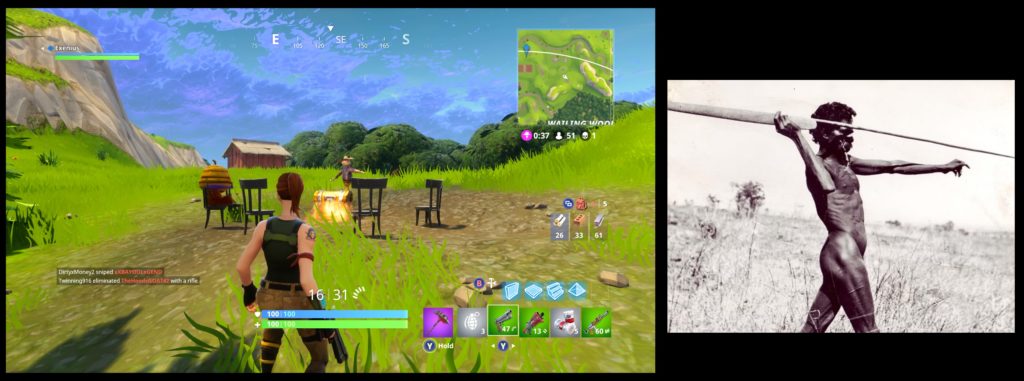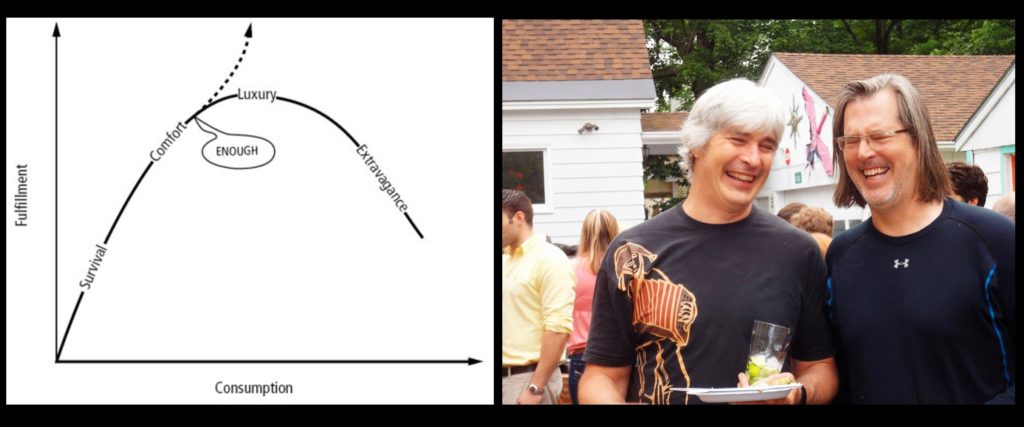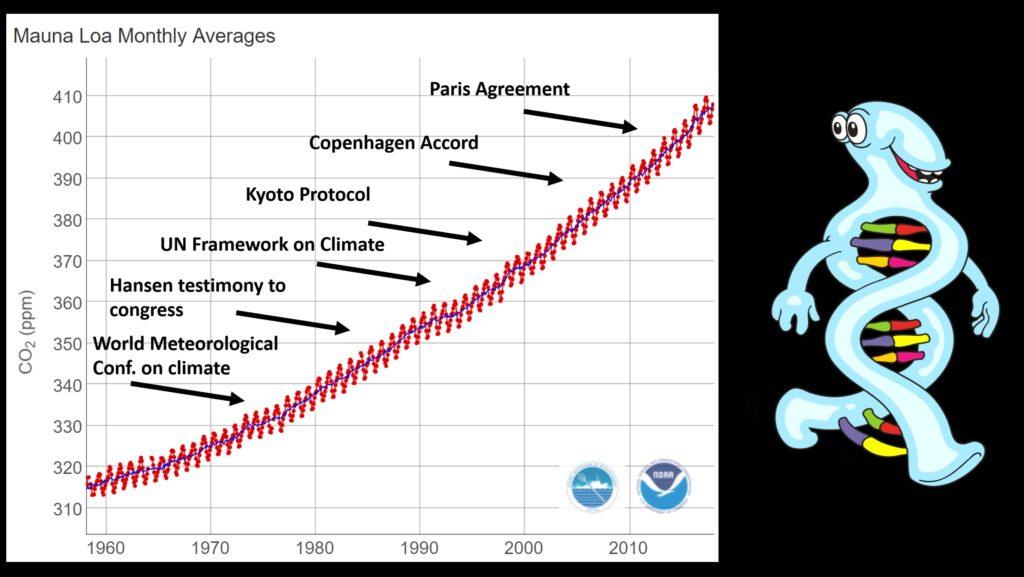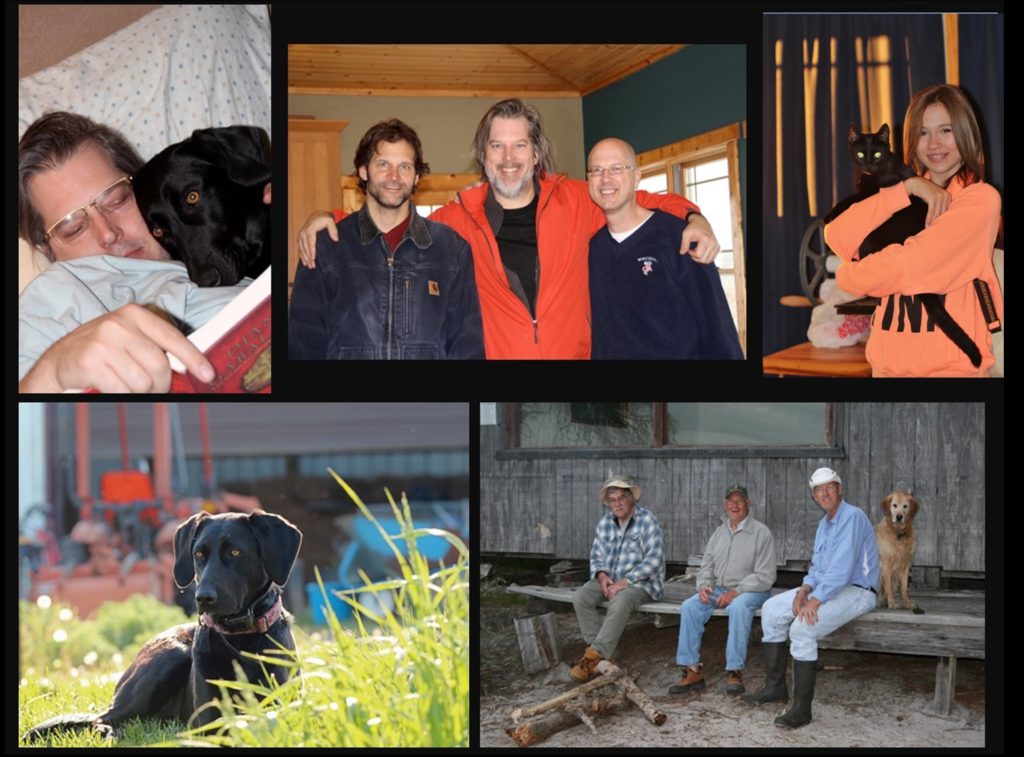Where are we going?
May 9, 2018
Ed. note: Nate Hagens gave this talk on Earth Day on April 23, 2018 at The Land Institute, Salina, Kansas. What follows is an essay loosely related to the talk.
The Human Predicament
Around 11,000 years ago, as the last ice age ended, our ancestors – in no fewer than 5 locations around the world – took advantage of the new conditions and tried an agricultural way of life. Fast forward through two momentous phase shifts in human history (agricultural and industrial revolutions), and here we are: approaching 8 billion, seeking freedom, experiences, and material wealth all derived from physical surplus. As many are aware, the procuring of this ‘surplus’ is also impacting the larger sphere outside our homes, (we call it “Earth”) in increasingly deleterious ways. Yet, at an annual global growth rate of 3%, which most governments and institutions expect, we would close to double the size of energy and materials it took us 11,000 years to amass, in the next 25 years.
Under current trends, a college student today would see over 2 such doublings in her lifetime. (yes, 2Xè 4X in size by the time they’re 70). Is this possible? Is this desirable? What are the variables that will influence this trajectory? What would be the impacts if it happens? And if it doesn’t? There currently is no natural entity in our society charged with such questions. Or answers to the questions. But perhaps there should be. A systems synthesis which integrates aspects of energy, the environment, the economy and human behavior is a prerequisite to understanding what is unlikely, what is possible, what’s at stake, and ultimately what to strive for and work towards.
The Key Continuums
My own conclusion is that The Next Doubling is now no longer possible. In the coming decade we are going to have to collectively deal with what I refer to as the Great Simplification. This will mean less physical throughput and fewer economic benefits to the average citizen in the developed world than the past 2 decades. If managed, the Great Simplification could result with positive outcomes and a saner system and very high standards of living vs most periods in our history.
Below is a condensation of some of the big themes relevant to this trajectory. On some of these “continuums and contrasts”, our current institutions and plans are far from realistic suggesting tectonic cultural shifts are necessarily on the near term horizon. (NB: this is the horizontal story – there is ‘vertical’ depth available on each of these points)
As we go through this list, the main 3 points of this talk will be:
- Energy underpins human economies. (We are living midway through the Carbon Pulse)
- We are headed for a world with less total consumption
- After basic needs are met, the best things in life are free
Energy/Economy

Energy vs Everything else – Human wealth and productivity is commonly attributed to our own cleverness (technology/productivity), existing wealth (capital) and hard work (labor). These inputs are important but in turn are all dependent – on energy. Modern economies eat power like animals eat food – every object and service in human economies first requires an energy input to convert it into something useful. Ergo, $1 of petroleum has orders of magnitude more value than $1 worth of pencils, paperclips or pastries. But energy, other than perhaps its dollar cost, is invisible to our society.
Flows vs Stocks – The human economy runs on natural resources like copper, iron and phosphorous. Globally $1 of GDP results in ~1KG of extracted minerals, energy and materials. We are particularly dependent on high density energy resources like oil and natural gas and from a long term perspective we are living during what might be called ‘the Carbon Pulse’, a one time bolus of fossil productivity injected into the human ecosystem. 98% of physical labor in modern world is done by machines which in turn are 85% powered by energy dense carbon compounds. Few think about it, but 1 barrel of crude oil, at 5.8 million BTUS, for which we currently pay $70, contains the work equivalent of 4.5 years of human labor, for which we pay (in USA) $140,000. The average American uses 54 of these ‘barrels’ per year directly, with an additional 10-20 via imported goods, equating to ~300 ‘fossil slaves’ supporting our lifestyles. In effect, though we eat ~2,500 calories via food, we each ‘consume’ over 200,000 calories per day overall. Our culture effectively treats all these geological inputs as ‘flows’ (like rivers, rain, sunlight, tree growth) but they are depletable stocks. No natural resource stocks are renewable on human time scales. Drilling holes is not sustainable. Our cultural stories conflate stocks with flows.
Stocks vs Abstractions – Stocks (oil, copper, phosphorous) typically follow predictable (gaussian) curves that rise, peak and decline. The amount of these ‘stocks’ we access has generally been increasing for over a century but has now started to decline in many cases (oil quality, iron ore grade, copper overburden etc). But our supply of money and credit continues to increase with no reference to the area of the curve remaining for these one-time natural stock endowments. (Globally it took over $4 of new debt to add $1 of additional GDP in 2017). We can print money, but we cannot print energy, only extract it faster with borrowed money.
Gross vs Net – We commonly count on the absolute amount of a resource, stock or reservoir available without considering the amount of it that can be technically or economically extracted. As we access the deeper, harder to find and more environmentally damaging resources, we spend an increasing amount of the key resources to get at the key resources. (E.g. static field decline for US shale oil is 30-40% per year, so production will now largely be a function of how many new wells are drilled). We have now left the era where our culture spent ~5% of our energy on finding and delivering energy, to one where we will be spending ~10% or even ~15% to 20%. This all manifests in higher costs and lower benefits for people and economies. As more energy is redirected to the energy sector, which sectors will get less/none? The net is ultimately what we are able to spend.
Joules vs Work – Energy can only be substituted by other energy. Conventional economic thinking on most depletable resources considers substitution possibilities as essentially infinite. But all joules are not created equally. There is a large difference between potential and kinetic energy. Energy properties such as: intermittence, variability, energy density, power density, spatial distribution, energy return on energy invested, scalability, transportability, etc. make energy substitution a complex prospect. The ability of a technology to provide ‘joules’ is different than its ability to contribute to ‘work’ for society. All joules are not created equally.
Economy vs Economics – The modern human ecosystem can be simply described. We use technology to convert energy and materials into products measured in dollars. We turn the dollars/products into neurotransmitters (feelings) + waste/impact. Repeat at larger scale. We often mistake a trend for a reality and a short-term pattern for an axiom of nature. In a modern (and relevant) case, we have constructed rules and ‘economic laws’ around a long-by-human-lifespan, but short-by-human-history unique period of time – where because of one-time inputs on geologic time scales, we’ve experienced continual economic growth for over a century. The constant growth we’ve experienced was correlated with human inventions and economic theories, but the cause was finding a bolus of fossil sunlight. We behave like squirrels living in a forest where a truck full of hazelnuts crashed, living off the freight and thinking it will last forever. Economic theories have -until recently – been right about describing our trajectory but for the wrong reasons – they largely ignore the physical and biological underpinnings of the human endeavor and will have to be reworked.
Behavioral
Human vs Animal – Humans are clever, unique and very capable. Yes, we are special, but we are èpart of the animal kingdom – part of the mammal and ape lineage. Our behavioral repertoire is amazing, yet still constrained and informed by our heritage.
Proximate vs ultimate – Why do we want that job? Why do we waste time on Facebook? Why do we love stock market returns? Why do we dislike that person? Why do we want to play with puppies? Why do we go to war? There are proximate – or ‘surface’ explanations for all these behaviors, but there are also ‘ultimate’ explanations based on our ancestral past. These “ultimate” explanations can predict and make sense of much of modern human behavior. Ultimately, we go through our daily lives seeking ‘brain services’- activities, experiences and behaviors in the modern world that provide the same ‘feelings’ that our successful ancestors got in a different environment.

Belief vs Facts – The human brain can imagine and speak many more word combinations representing reality than exist in reality. As such the virtual world in our minds seems more real to us even in the face of science, logic and common sense. And since we construct our own individual virtual worlds, we prefer them over the virtual worlds in others’ minds. Which is why ‘beliefs’ are far more powerful than facts. Beliefs usually precede the reasons used to explain them. Which is why fake news works and why we find it extremely difficult to convince people about climate change, energy descent, the limits of technology, etc.
Now vs Future – We are biological creatures with finite lifespans. For good evolutionary reasons we disproportionately care about the present more than the future. But most of our modern challenges are ‘in the future’.
Supernormal vs Normal – Modern technology provides stimuli orders of magnitude higher than our ancestors seeking similar feelings experienced. For them, a berry found on their path was a rare sweet surprise, while we buy sweets by the pound at the grocery store, or shipped via Amazon. We can easily become hijacked/addicted to things that ‘feel’ important but are just ephemeral action-potentials in the brain, not in the real world.
Relative vs Absolute – Fitness in nature is correlated with caloric intake per unit of effort. We each follow this simple ‘foraging algorithm’, mediated by the neurotransmitter dopamine, to get more for less. But after basic needs are met, this algorithm shifts to caring significantly more about our comparative performance, income, status, ranking vs others than we do about absolute measures of same.
Wants vs Haves – Our impulses to want something – a pair of shoes, a new car, a toy – feel more intense to us than the satisfaction we get from the possessing of that thing on ongoing basis. Which is why our basements and storage units are full of the ghosts of dopamine past. While our physical world is based on stocks, our brain and behavior is based on flows, which need to be continually experienced each and every day.
Wants vs Needs – Once our basic needs (food, water, basic services, social respect) are met, we get very little additional life satisfaction from increased consumption.

Me vs Us – We are a biological species, and as such on the spectrum of competition vs cooperation, we are generally looking out for #1 – ourselves and our family-relative to others.
Us vs Them – But our formative years (millennia actually) were in small nomadic tribes on the African savannah. The success of our tribe -in hunting, resource acquisition, and defense against other tribes, dictated – and often trumped – our own individual success. This intense favoring of ingroups and ostracizing of outgroups – be they different religions, different political groups, different sports teams or even just different opinions about the future – remains with us today.
Genes vs Culture – Human nature does not change in the short term- our great great+ grandchildren living in 200 years will be subject to all the same drives and constraints I just mentioned. But culture can manifest emergent behaviors -both positive and negative – that can happen on much shorter timelines, even less than a decade in some cases. Our genes tell us what we need, but culture dictates how we get it. We can get at least a good portion of ‘what we want and need’ using less stuff with less damage.
Environmental
Internal vs External – In the modern formulation of the market system, we internalize profits and externalize costs. The costs -of pollution and negative social impacts-, are born by the commons and the public, which includes other generations and other species. No industry in the world would be profitable if full cost pricing were to include all externalized costs (e.g. damaging impacts of coal ($0.38 kWh full cost instead of $0.04). But most other species don’t care at all about externalities, and as we become socially aware of our downstream effects, we have done more to respond to the costs. Relevant examples include DDT, chlorofluorocarbons, polluted rivers, and unleaded gasoline. But CO2 remains an impact that can’t easily be ‘internalized’.
Treasure vs Riches – The vast ecological riches of our natural world: mineral deposits, millions of species, vibrant ecosystems, lush rainforests, etc. are only counted as having value to human economies once they are converted. In our quest for treasure, we have plundered our riches, and the default plan is to continue to.
Civilization vs Community – Humans now appropriate between 30-40% of the annual productivity from sunlight interacting with soil/land on our planet. Additionally, we (and our cows, pigs, goats, dogs, sheep, etc.) outweigh the sum total of all other terrestrial vertebrates by a ratio of over 50:1. The continuum between human civilization and Earth community – at least so far – has been solely headed in one direction.
Seen vs Unseen – Many of the ‘externalities’ of human commerce we can only read about. Today looks very similar to yesterday. Yet: E.g. France (and other countries) has lost 1/3 of its bird population in the last 15 years across the board due to fewer insects (presumably due to pesticides), sea creatures 10km deep are found to have more toxic chemical concentration than in polluted Chinese rivers, we have lost 50% of animal populations since the 1970s etc. Human sperm count in the developed world has dropped ~50% in past generation. The ocean has lost 2% of its oxygen in the last 50 years, etc. We focus (naturally) on the seen – but the unseen currently tells a worrying story.
(The preceding 21 points can be (and will be in a separate document) supported by modern science. The points below are logical implications from the above synthesis, but as presented are more my own conclusions.
Cultural
Heat Engine vs Intelligent Foresight – In modern human culture we cooperate at various scales (individuals, corporations, nations) to maximize representations of surplus (monetary profits). Once we understand that 1) all goods and services leading to economic output first require a primary resource conversion, 2) GDP is highly correlated with energy, 3) to provide ‘brain services’ to as many people as possible, governments and institutions do whatever they can to keep access to energy growing. (credit creation, rule changes, guarantees, etc.) the common economic statistic Gross Domestic Product takes on a different connotation. To a reasonable approximation: GDP could be renamed as GDB – Gross Domestic Burning, as underpinning every economic transaction, a small fire happened somewhere on earth. From a birds-eye view, modern human society is thus functioning akin to an energy dissipating structure. With a collective focus on short term profits, we tacitly assume the best futures will naturally arrive. But viewed from a perspective of GDB, the market itself cannot use intelligent foresight, only march forward, 3 months at a time.
Narrow vs Wide – Each issue we encounter has different correct answers depending on how wide a perspective is used. We can look at the impact of a policy on e.g. the taxi driver, on the taxi company, on New York City transport system, on New York City itself, on USA, on the world today, on future generations, on ecosystems etc. Most current predicaments are viewed from a wider boundary perspective, but most cultural decisions are made using narrow boundaries.
Finance vs Natural Science – In the 20th century we constructed societal infrastructure and expectations on rules from finance and economics, but the rules from natural sciences and ecology: primary productivity, trophic cascades, carrying capacity, overshoot, bottlenecks, phase shifts, succession, pulses, etc. are going to be much more pertinent in the 21st.
Unlimited vs Limits – Imagine a world with 7.6 billion humans and no laws. No speed limits, no taxes for public infrastructure, no rules, no courts of law, etc. Humans instinctually have problems to self-impose limits. So, via social contracts and reciprocity, we have learned to recognize the importance of such institutions, and as a result, society is better off. Though we have recognized the importance of rules and constraint on personal behavior and impact, we have not yet matured to recognize limits for society at large.
War vs Peace – Historically in times of fewer resources per capita, earlier human societies (and tribes before them) went to war. But this continuum is so often avoided in discussions that it needs to be mentioned. We will go to war again if we don’t manage to cooperate to solve the future constraints in a constructive way, and there are ways. This time, war would be much more devastating than ever before in human history. We have had anti-war movements in the past and hopefully will again in the future – what % of our ‘carbon windfall’ is directed to military spending? In a peaceful world where might it better be directed?
Population vs Consumption – We are 7.6 billion en route to 9-10 billion. UN (and other international institutions) misunderstand the energy primacy underlying human economies. Does a carbon pulse informed synthesis imply substantially lower populations this century? No. Unless some of the 4 Horsemen of the Apocalypse show up, by far the more likely scenario is a maintained high population level, with less resources per capita (maybe considerably less). Malthus was “right” but missed the ‘vertical revolution’ of fossil carbon. Ehrlich was “right” but missed globalization and the birth of credit markets, pulling resources forward in time. Perhaps someone today hearing this story immediately expecting large population die-offs based on resource constraints will also be ‘right’ but miss the more obvious trajectory of consumption decline rather than population decline. In the developed world, where people consume 50-100x their food consumption for other things, there is a lot of room to go down without affecting wellbeing. So less consumption is still viable, and even desirable. With 350,000 new babies born each day globally but 350,000 people/families per day also entering the global middle class, with ~5:1 higher throughput than the average, the ‘population’ issue takes on a different flavor.
Intelligence vs Wisdom – Human history is replete with quite intelligent and otherwise successful cultures which simply got something about the big picture crucially wrong. Easter Islanders believed that resources flowed from the good will of their ancestors, so it was only logical to cut down all the trees to aid in the construction of ever-bigger stone heads. Their behavior was clever but not wise. Our culture similarly rewards reductionist viewpoints and expertise in solving problems. But as we increasingly reward vertical expertise within a discipline, we lose the wisdom that comes from crossing disciplines. Simply put, intelligence and wisdom work best in synergy. Modern humans, with ample intelligence but a dearth of wisdom risk becoming idiot-savants, metaphorically pushing levers in increasingly clever ways, for building modern versions of the stone heads on Rapa Nui.
Trivia vs Relevance – Our Education system is becoming less relevant for the future we are facing. Primary and secondary education are a product of energy surplus. Paradoxically, they also are one of the few investments that can contribute to ‘future surplus’. Education from a lens of intelligent foresight would focus on science synthesis, understanding our own minds, on ecological principles, dealing with uncertainty, and on the problem-solving skills which will be increasingly needed in a lower-energy-throughput society. Less specialization and more systemic understanding would be the order of the present day.
Dollars vs Humanity – Of all the supernormal stimuli in modern culture: social media, twitter, Overwatch, slot machines and meat lovers pizza, perhaps the largest and most pernicious is ‘dollars’. We have managed to parse the entire inventory of what made us function in tribal conditions over tens of thousands of decades into one variable: digital/linen markers of status and success. We certainly need currency for transacting and storing wealth, but our culture has taken it to an extreme, gradually but almost completely financializing the human experience. One can hope that a vast pool of expressions of humanity lies dormant beneath the stacks of electronic digits.
Good vs Evil – Humans are not evil, not any more than wolves or wildebeest. However, at 8 billion strong, pursuing surplus correlated with finite source and sink capacity, our actions have ‘evil outcomes’. It is important to not conflate our collective impact with who we are as individual life forms. What is happening is no one’s fault, but we are all complicit.
Should vs Will – Many people are promoting campaigns for what our society ‘should’ do to solve our myriad of? economic and environmental problems. But most of these recipes, -with albeit laudable goals – are either incompatible with our physical reality or with behavioral patterns evolved over hundreds of thousands of years. Banking on ‘sudden insight’ into the greater good by a majority of people is something environmental activists have done since the 1960s, and climate activists for almost 2 decades, yet we’re still emitting more CO2 every year. It is unlikely we will en masse prepare for the Great Simplification ahead – the cultural, behavioral and systemic barriers are too large. Relative to planned “change”, we will instead “react and respond”. Instead of advocating for unrealistic outcomes, we can put effort towards changing the initial conditions that will result in better outcomes and then make new moves – currently not on the gameboard, possible.

Popular vs Realistic – Similarly, a full accounting of the severity of our predicament – on radio, television and in papers, will never be popular. It’s much more comfortable (and profitable) to be entertained, marketed and promised various contrived solutions, usually with some unproven or physically unscalable technology, or based on hard-to-detect fantasy ignoring natural science. We should recognize that glib solutions, typically aren’t solutions. But acknowledging that would be… distressing, and unpopular.
Left vs Right – Other than perhaps climate change, both democrats and republicans are both sharply divorced from the realities of our coming challenges. Resource depletion, credit overshoot and the accompanying systemic risks are absent from any political conversations. Instead, substantial energy (and vitriol) are expended on the things an increasing polarized society disagrees on. We will one day soon appreciate (and hopefully engage with) the issues that most of us agree on: basic needs, family/friends, healthy food, peace, respect, meaning, and a safe and clean environment for our grandchildren to grow up in. As such the current arguments between Republicans and Democrats is akin to arguing about which mosquito repellent is best to put on our arms, while a crocodile has our leg in its mouth.

Economy vs Environment – If you could create a list of the 10 best ways to improve the environment, (e.g. carbon tax, protecting international fishing zones, driving curfews etc.) it would be likely all 10 would be bad for economic growth. Similarly, a list of 10 best ways to grow the economy (e.g. baby subsidy, tax rebate) would all likely make either the micro or macro environmental situation worse. This century, we are going to perpetually make decisions (or not make decisions, just act) on a spectrum between what’s best for economic growth, and what’s best for planetary ecosystems and our long-term wellbeing. It’s probably good to realize (and care about) this upfront.
Rights vs Right – There have been many social contracts in recorded human history. From the Code of Hammurabi 3500 years ago to the Magna Carta and U.S. Constitution, humans have often created rules and guidelines to properly delineate the needs and circumstances of the time. We now live on an ecologically full planet – and are aware of what we are, where we came from, what we need, what we want and what we are doing – to each other and to our surroundings. With this backdrop there is a distinction between ‘right’ and ‘rights’. This continuum will remain a back-burner item. Until it moves to the front burner.
Individual
Certainty vs probability – The future exists as a probability distribution of: very bad, bad, so-so, benign and very good futures. But people dislike uncertainty. When we hear about the all these energy and environmental scenarios we typically either a) reject or deny the implications using rationalizations along the lines of ‘technology will solve it’ / ‘we’ll think of something’ etc. or b) ‘it’s too late – there’s nothing we can do -might as well enjoy the day’. These reactions seem the opposite on the surface but have two things in common: 1) they create dissonance resolving ‘certainty’ in our minds and in turn 2) they obviate the need for personal response and engagement (which would be uncomfortable emotionally and physically). The reality is that future is not yet determined and exists as a constantly shifting probability distribution based on events, technology, wisdom, risk and the actions of individuals and communities. We need more people to avoid the two poles of denial and nihilism and stay in the center, own a bit of dissonance, and engage.
Less vs More – We have financialized the human experience, parsing everything of substance, depth and meaning from our tribal past into electronic/linen markers. Once our basic needs are met we don’t really want more, we just want more than the guy/gal next door. We are headed for a world with less physical throughput whether we choose it or not. But this does not mean we have a world of ‘less’ experiences, happiness, meaning and good lives. The average Guatemalan makes under $10,000 per year but has life satisfaction and quality the same as countries with 5-10X as much income. Less and more need to be unpacked beyond their monetary labels and the gut reaction to hearing them. As individuals we can strive to be happier with absolute wealth and focus less on relative (this takes training and effort).
Crazy vs Sane – At 50x the income of humans 200 years ago, it is no wonder the average American is so distracted by convenience and lulled by false narratives as to be asleep to the real issues. People aren’t idiots nor are (most of them) liars. But we are so often seduced and misinformed by simple narratives that those warning about the converging macro crises are generally considered crazy by the mainstream. But to be ‘woke’ to the issues of the day is perhaps the only route for sanity. Owning a bit of grief and dissonance about what’s happening is eminently rational, even if it feels bad at times. If worrying about the 6th mass extinction, energy descent, limits to growth and the coming Great Simplification makes one crazy, well perhaps the world needs a whole lot more crazy. We have temporarily confused crazy and sane.
Consumption vs Meaning – At 80x more energy than our bodies need, possessing the metabolism of 30-ton primates, even the median among us live material lifestyles above most kings and queens from centuries ago. And yet many people are miserable, over-fed, over-medicated, and unsatisfied. What we lack amidst this smorgasbord of riches is a feeling of community and a true sense of purpose. Inferred by all the other points in this presentation is the obvious fact that the future needs our help. Yet most people have no concept or even belief in ‘the future’. Perhaps from awareness of our situation, the stakes, and the possibilities there may emerge a (very large) tribe connected to Tomorrow.
Thinking vs Doing – In a world of inexpensive do-overs, we have become accustomed to large wastes of time. We spend considerable time pondering esoteric theories or distracted by gadgets without learning or understanding physical skills. As our fossil slaves cease to be woken, we will increasingly have to resubstitute human labor for carbon – and it would behoove each of us to learn a physical skill. Or three.
Grief vs Joy – We like happy, carefree stories with wonder and imagination, well, because it’s comforting and nice to be happy and carefree. Part of us knows that things aren’t right, and we strive to deny that fear in things that cocoon us in comfort. Alas, the stage of our current world, approaching social limits to growth, while squeezing out the natural world a species at a time does not lend itself to a happy and carefree demeanor. It is acceptable – and even appropriate – to carry with us some grief and dissonance about our situation – because it is a perilous one. Accompanying this grief perhaps we will be resolve, anger and creativity to direct towards future related goals. But we also need balance. While holding the grief, we have to find time to refresh the white snow in the paths in our minds, with, variously: music, Netflix, beer, golden retriever puppies, night skies, old growth forests, and deep friendships. It is a wonderful and perilous time to be alive. Let’s not forget the ‘wonderful’ parts.

Hope vs Despair – Whether one feels hope or despair depends on one’s prior outlook. If you expect 12 billion people living like the average American in the year 2100, with flying cars and all climate and ocean issues solved via tech fixes, then the future painted here might look on the dark side. If instead you envision 5-6 billion humans, living a low-tech society with renewable systems, we’ve only lost 1,000 of our remaining 5,500 mammalian species, climate has stabilized under 2C, and we’ve avoided nuclear wars, then there is a great deal to be hopeful about as that future and many like it are still on the table.
Conclusions
We cannot know the future, but we have reasonable confidence of what it will not be. The peak in fossil sunlight flow rates and resultant higher costs will mean major changes in our lifetimes. We can be reasonably sure the average energy/material throughput for Americans – and global citizens, particularly in advanced economies, will decline in coming decades. It’s important to point out that a 30% drop in material wealth per capita (for those in the United States and Canada) though sounding draconian, brings us back to 1993 levels – a 50% drop would bring us back to 1977 levels– both periods nobody considers economically challenging. How we respond to this energy descent as individuals and as a culture will be a deciding moment in our history.
All the ‘cultural’ and ‘individual’ observations above coalesce to a fine point: we are capable of much more, but are unlikely to alter our current trajectory until we have to. And when we add in the economy and environmental points: we will soon have to. Recognizing this, the next step is urgently discussing and cataloguing what initiatives might be worked on by small groups using intelligent foresight nationwide.
Given we have ~100:1 exosomatic surplus buffer, there remain a great deal of benign, and even excellent futures still on the table. But they won’t arrive without effort. The world isn’t irretrievably broken, the Great Simplification has barely started, and there are quite a few people who are discovering exactly the shape of our predicaments, and the nature of the things which could substantially change them.
NB: While I believe education itself is insufficient for major change, it is still a necessary first step so that pro-social engaged citizens work towards feasible and desirable goals and react to events in more rational ways. My own goal with this content is threefold:
- Educate and inspire would-be catalysts and small groups working on better futures to integrate a more systemic view of reality
- Empower individuals to make better personal choices on navigating and thriving during the Great Simplification coming our way
- Change what is accepted in our cultural conversation to be more reality based
Dear people of Salina and Kansas, I invite you to participate in the future.
Teaser Image: D’où Venons Nous / Que Sommes Nous / Où Allons Nous. P. Gaugin 1897
Originally posted at Resilience.org.
